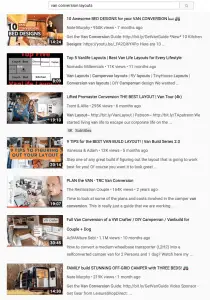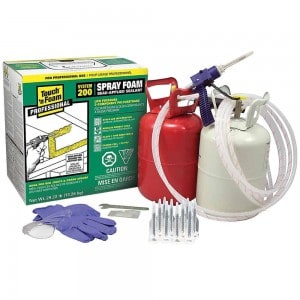Having spent years watching the #vanlife movement explode in all sorts of directions, we decided that if we were to get the van we wanted, we were going to have to build it ourselves. Despite both of us (James particularly) being more than capable of slinging together a camper with a bit of gaffa tape and a bunch of old pallets, our requirements present a somewhat more technical challenge so we decided to document the entire process so here it is – how to start a winter van build (part 1).
How do you start a winter van build? To start a winterised van build you need to do a lot of work in the planning phase. The first thing you need to do is write a list of your personal priorities and then put them in order of importance.
The trick with a winter van build really is to start as you mean to go on, otherwise the likelihood is you’ll get into a right pickle, fairly early on in your project. Like on day one.
As we suggest, we started with a priority list, even before we gave eBay motors a glance. This proved to be the beginning and end of our excellent planning phase, as once a thrifty 5 minutes had been dedicated to this important task, we got stuck in the rabbit warren of the internet, looking for a van.
The 7 Ps
You’ve heard of the 7 Ps right? If not, look it up now and then pin it to the wall, write it on the mirror and tattoo it on your forehead.
If you catch yourself looking at base vehicles any sooner than 5 weeks after you have dedicated yourself to building your own winter van conversion, you are jumping the gun. Unless of course you are working with a professional conversion company who, if they are any good, are going to limit your options to those few that they know work.
You need a whole lot of time to wrap your head around everything you need, how much you’ll be investing in each element, and what compromises you are willing to make.
Everyone begins a van build, however modest, with an entirely unrealistic wish list. Enough solar to power Wembley; a jacuzzi bath; a chest freezer and a cinema room…. All things you can’t understand for the life you why someone hasn’t thought of putting these in their Transit Connect before?
Now you need to start your list again with more sensible things like, “where will I be able to keep my screen cover without flooding the van”(in the jacuzzi obviously) and “if we limit the spare pants we might be able to take more salad cream”. Much more sensible.
Now think again and again and again. If you’re building with a buddy or a partner, you’re going to really need to work hard at this bit because we won’t lie, it’s annoying. I really find it irritating that we have to configure the entire layout of our van around a set of skis that are too long for anyone who isn’t a Freeride World Tour competitor. James, will equally express his distaste at having to think up some fold away wizardry to accommodate my instance that our shower magically vanishes when not in use.
Rather than setting things in stone, we recommend using this period for ruminating. Nobody does enough of this anymore. You need to chew things over and as soon as you add a new requirement into your van, everything else tends to shift a little bit – or a lot (like out of the door completely).
If you want to browse some bits – Outdoor Bits (link below) is a pretty decent place to get lost in for a few hours!
Here’s what you need for this initial phase of planning a van build:
 YouTube– dedicate hours of every day to trawling YouTube for ideas of layouts – most people are reasonably honest about how they find their design so you can pick up lots of tips
YouTube– dedicate hours of every day to trawling YouTube for ideas of layouts – most people are reasonably honest about how they find their design so you can pick up lots of tips
You do need a toilet– honestly you do – just start thinking about what type you want and how you can fit it into the grand plan and every time you catch yourself thinking of ditching the loo, slap yourself around the face
A notebook/box/file– or whatever you use for collating thoughts. Old fashioned it may be, but scrapbooking is a really good way to do this. You will forget something you set in stone on Sunday by Thursday when you realised that it was totally possible to put a hammock on the roof for a spot of sunset Après. You can use also Pinterest (this is our page for those of you into that) but we still cut and print stuff out and keep it in a box – it’s kind of fun.
Start assembling your tribe– you need a lot of stuff you probably haven’t got for a van build so you need to start networking.
You will need somewhere dry to do your conversion otherwise it’s going to be a nightmare. Thinking about this early is a good plan because it might cost you – if you can roam around trying to find a friendly farmer or property owner who doesn’t mind a squatter, you’ll be able to spread all your mess out and work more efficiently.
You’re also going to need tools. Obviously, there are people who chuck their vans together and hit the road – more power to them… that’s not an option in a household that has a tradesman in it – we’re doing a proper job and that requires proper tools. Our garage currently has enough equipment to rebuild the Titanic but you don’t need everything. You just need to know everyone! Start asking around – if you can find someone with a plainer, a band saw and a compressor, you can rent the rest of the stuff you need quite cheaply – or buy it in many cases. Also keep an eye out on Facebook Marketplace which is a great place to pick up used tools (mostly from the garages of old dead folks).
Budget consideration– nobody starts a van build without either a set pot of cash or an idea of how much they can, or are willing to spend on the project. Whatever you think it’s going to cost, you need to accept that it will be double or, more likely, you will have to make a lot of cut backs at some point. The sooner you get your head around this, the better. For example, you think you need precisely X metres of vinyl for your floor? You need at least three times that because:
- You won’t have measured correctly in the first place
- You will cock it up at least once and mis-measure something
- Then you will probably settle for the fact that you “won’t see that bit anyway”
Joking aside – budget is a big deal and is what causes a lot of part-converted vans to end up on eBay. Good 3-way fridges are VERY expensive. Good batteries are extortionate and winter tyres are going to set you back a bit too.
If you’re worried about the cost running away and you have a sensible chunk of cash – talk to a conversion company. They know what they’re doing, if they mess up the measurements it’s on them not you, and if you have zero skills and inclination – they’re your best bet. A little plug for our mate Jonny Ashworth in Devon – a seasoned motorhome skier who has his own successful conversion company – definitely worth a call.
This is phase one now complete. You must not progress to phase two of a winterised van build until you have really committed to phase one!
Phase Two – Insulation
Do not get ahead of yourselves. We are still only thinking – we don’t do thinking with our hands.
You know you have to strip out your van, that’s a given, so the next thing you need to really start thinking about is how you’re going to insulate your van. If you are serious about making a rock-steady winterised van, then this is the absolute foundation of your van build. Get this right and you will be able to throw a mattress in the back and get gone – #vanlife style.
We have been thinking about van insulation for almost 3 years.
We’ve completed YouTube – there’s nothing left on the platform that we haven’t seen about van and motorhome insulation. We’ve watched every success story and screw-up. You might not know this but if you do a van conversion, it’s actually compulsory to film it for YouTube, that’s how we know we’ve seen ALL of them.
Still dissatisfied, we went down the route of talking to the following people:
- An automotive manufacturer – i.e people who actually build vans – the metal bits
- Scientists – real ones who know about the thermal properties of various materials and how they perform under different conditions and circumstances
- Van heating manufacturers – they’re a critical part of a van ecosystem so what do they think about insulation?
- A plumber (have one in house so that’s all good)
- Building experts
- Boaties
We’ve always had the philosophy that if it’s good enough for a boat, it’s good enough for us so a lot of the inspiration for our winter van conversion has come from the marine world. It’s damp and cold much of the time – that sounds like just the sort of environment we’re know well.
Our Conclusion on Insulation
We looked at a whole load of options and later on we’ll include the spreadsheet we used to analyse the various insulation options open to us and show why, ultimately, we’ve chosen a spray foam solution.
We’re screwing this one up so you don’t have to
We looked around and costed up getting a company to do this for us but concluded that whilst comparable in price, we’d rather do it ourselves. The flexibility to change things up as we go was critical to making this decision and in the coming Van Build blogs and vlogs, you’ll see why.
We are extremely fortunate in that with our winter van build, we have a ‘test vehicle’. We have never done a van build before and we are taking the whole thing pretty seriously, so James has kindly donated his VW T5 Transporter to the cause – and she’s about to get toastie!
First thing we’ll be doing is insulating the T5 – it’s considerably smaller than our touring van and gives us the perfect opportunity to test out the DIY foam kit that we have. It seems pretty straight forward but experience tells us that second time around, once you know all the tricks, you’ll get a much better finish and as my old boss once told me – you never waste time or money on a recce… that’s a rule to live by.
If using foam to insulate your van is something you’re interested in jot your email address in the box below and you’ll get the updates as they come.
The next parts in this winter van build series are about acquiring a van and choosing insulation (in depth). We went a slightly unconventional route and we’ll see if this pays off in the long term.
[yikes-mailchimp form=”1″]
Related Questions:
How can I keep my van warm in winter? There are lots of options open to you if you want to convert your summer camper into a fully-fledged winterised van. Installing a simple diesel heater might be enough for a few weekends away but if you’re planning a campervan ski trip you should consider stipping out and insulating from the shell in.
Can I have a log burner in my camper?You can but it’s not a good idea for a lot of reasons. Firstly, you will not be able to get insurance for a campervan with a solid fuel burner in it in the UK. Secondly, unlike narrowboats for example, vans are not designed to house stoves and fires.
Can I winterise my motorhome?If you already have a motorhome or campervan that’s not quite up to the job, there are many things you can do to make it winterised for a motorhome ski trip.

